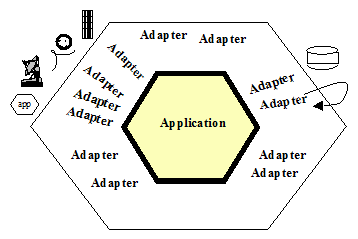
A (small) Hexagonal architecture
inside a Symfony application
By Alessandro Lai / @AlessandroLai
IT Meeting - 18/03, Facile.it
Hexagonal Architectures
- Concept created by Alistair Cockburn
Hexagonal Architecture is an architecture defined by establishing a perimeter around the domain of your application and establishing adapters for input/output interactions.
By establishing this isolation layer, the application becomes unaware of the nature of the things it's interacting with.
Scheme

Hexagonal Architectures: TL;DR
- The hexagon is the core of you app
- The hexagon contains all the business domain logic
-
The hexagon communicates
ONLY through ports and adapters
So...
-
Why so popular right now?
- Microservices!
-
Why don't we see it so much?
- Complicated
-
Hard to start with
MonolithFirst by Martin Fowler
A little history...
- Listened to a XPUG presentation about it
-
At the same time, I was nearly ready
to start a new project...
Blaine
-
Shiny new technologies
- PHP 7 (yay!)
- Symfony 3
- Docker & Docker-composer
-
Looked like a microservice...
- Isolated
- In charge of a single domain (invoices)
- Adapter from BU to accounting software
Complications
- A microservice is surrounded by other microservices
-
MVP was substitution of previous system
(Caronte) -
Couldn't force all the clients to change immediately
(Shark, Cougar)
Change of plans
What if we use hexagons as a design pattern
instead of an architectural one?
Bundles as hexagons
-
InvoiceBundle
core domain -
ApiBundle
REST endpoints -
PDFBundle
invoice as files -
WebPanelBundle
a simple web interface -
ESABundle
adapter to accounting software
InvoiceBundle
I used the technologies as adapters:
-
Doctrine
- Entities as persistence and domain model
- Additional models and interfaces to avoid exposure of core
-
Symfony validator
- On entities to enforce business logic and reject errors
-
Symfony services
- Adapters/ports from/to the hexagon or between bundles
ApiBundle
-
POST: creation of new invoices
- Should emulate same behaviour of previous API (Caronte)
- POSTing is tested to ensure similarity
- Some changes where required anyway...
-
GET: fetch the invoice in PDF format
-
PDFBuilder (adapter to hexagon)
-
InvoiceLocator Repositories
(adapter from Blaine to Caronte DB)
- PrintableMappers (adapter to PDFBundle)
-
PDFBuilder (adapter to hexagon)
PDFBundle
-
PrintableModels
- Level of abstraction
-
PrintableMappers
- Adapter from other bundles
- Internal rendering of PDF (Twig + PsPDF)
- Result is sent back as file content (string)
WebPanelBundle
- Bootstrap
- Simple web interface
- Just an interface for the services of the bundles
ESABundle
- Work in progress...
- Internal models (isolation)
- Easy to replace